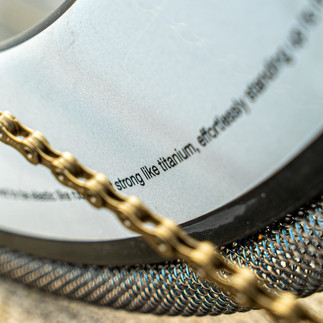Bicycles from Mars and a Shape Memory Material
- Efrat Barak
- Sep 25, 2023
- 3 min read
Updated: Mar 25
In a lecture I gave at the HIT annual conference about two years ago, I talked about NASA's Mars rover, Curiosity, which was launched to Mars in 2011 and still roams there today. This rover manages to survive far beyond the two years originally allocated to its mission, but one part of the rover quickly proved problematic - the wheels. Due to the harsh terrain on Mars, it turned out that the aluminum wheels wore out much faster than expected. The Martian rocks literally created holes in them, raising concerns that the rover would get stuck before the mission's end.
To preserve the wheels, NASA decided to change the rover's driving strategy, ensuring that most of the driving would only take place on soft terrain, allowing the mission to continue to this day. Simultaneously, to enable space missions on challenging terrains like the rocky areas of Mars, NASA's engineering team continued to work on developing the wheels. The breakthrough came when, together with materials scientists, they decided to develop a wheel built from a kind of springy metal mesh, hollow inside. The springs are made of a shape memory alloy (SMA) composed of nickel and titanium, called Nitinol (NiTinol). What's special about this alloy is that it has shape memory and superelasticity. That is, the alloy knows how to maintain and return to its shape even after repeated bending and pressure. You could say they reinvented the wheel (sorry, I couldn't resist), and the big innovation is that it's an airless wheel, which doesn't get punctures and maintains its elasticity and usability in very harsh conditions without the need for repairs. This development naturally sparked imagination for possible applications of airless wheels on Earth as well, and so The SMART Tire Company (STC) was founded in 2020 as part of NASA's FedTech entrepreneurship program.
Right: The Nitinol wheel developed for the space rover. Center and left: Prototypes of a Nitinol wheel for bicycles. Photos courtesy of The SMART Tire Company. The SMART Tire Company
About a week ago, one of these applications, an airless bicycle tire, was announced as commercially available. Almost. Based on NASA's original SMA technology, the new tire contains a Nitinol (nickel-titanium) shape memory alloy spring with the elasticity and strength of rubber, and is covered with a highly durable polymer rubber. According to publications, the new tire uses about 50% less rubber than a traditional tire and is designed for 'lifetime' durability, with punctures not affecting its functionality since its main functionality is based on the metal alloy. Beyond saving the hassle of puncture repairs and trips cut short because of them, the technology based on an innovative material offers a reduction in tire consumption, which is a very difficult waste to recycle. The new tire is still relatively expensive compared to standard tires, but will certainly suit those who ride a lot. A Kickstarter campaign for the tires is currently running. You can also join the waiting list on the company's website, which, by the way, is already working on developing similar tires for scooters and motorized vehicles.

'Martian' Astro-Bicycles. Photo courtesy of The SMART Tire Company
The Verge made a great video explaining the original development, research, and applications of Nitinol over the years, and also a detailed article on the current development.
Various versions of the bicycle wheel from development stages. Photos courtesy of The SMART Tire Company
רוצים לגלות עוד על חדשנות בחומרים? מוזמנות ומוזמנים להירשם לניוזלטר לקבלת עידכונים על כל הנעשה בתחום, להכיר, ליצור קשר ולקבל מידע על שירותי הייעוץ, המחקר וההרצאות.


















